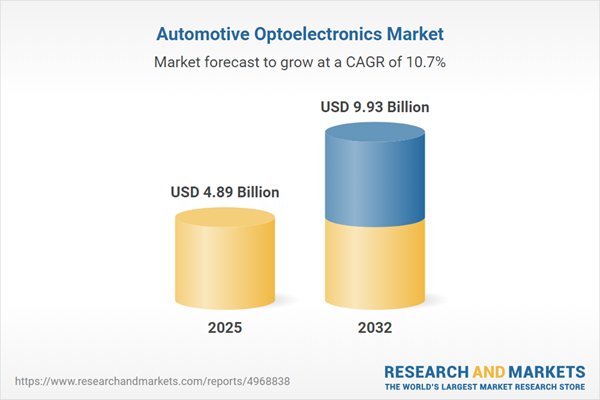Speak directly to the analyst to clarify any post sales queries you may have.
The automotive optoelectronics market is rapidly evolving, fueled by rising demand for smarter, safer, and more connected vehicle experiences. Decision-makers seeking to innovate and lead in mobility technology will find actionable insights here to inform strategy and guide growth initiatives.
Market Snapshot: Automotive Optoelectronics Market Growth
The automotive optoelectronics market grew from USD 4.41 billion in 2024 to USD 4.89 billion in 2025, with expectations to maintain a CAGR of 10.65% and reach USD 9.93 billion by 2032. The market is experiencing robust expansion, reflecting sustained investments in digital cockpit interfaces, advanced lighting, and vehicle safety systems driven by regulatory and consumer demand. Stakeholders are responding with accelerated R&D, localized supply strategies, and greater system-level integration across global production networks.
Scope & Segmentation of the Automotive Optoelectronics Market
This comprehensive report examines core dimensions that influence opportunity, competitiveness, and strategic decision-making within the market.
- Product Types: Display panels, exterior lighting, interior lighting, and sensing systems.
- Display Panels: Headup displays and HMI displays centralize navigation, entertainment, and driver information.
- Exterior Lighting: Laser headlights, LED headlights, and xenon headlamps improve illumination and energy efficiency.
- Interior Lighting: LED ambient lighting and mood lighting enhance cabin personalization and comfort.
- Sensing Systems: Integrated infrared sensors and LiDAR sensors empower advanced driver-assistance functions.
- Vehicle Types: Commercial vehicles, electric vehicles, hybrid vehicles, and passenger vehicles, each with tailored technology priorities and service requirements.
- Technologies: Infrared, laser, LED, and OLED advances shaping new functionalities and efficiencies.
- Sales Channels: Aftermarket channels and original equipment manufacturer distribution routes address both new builds and retrofit opportunities.
- Applications: Illumination, information display, sensing-based safety enhancements, and signaling systems.
- Geographies: Americas (including United States, Canada, Mexico, Brazil, Argentina, Chile, Colombia, Peru), Europe, Middle East & Africa (covering United Kingdom, Germany, France, Russia, Italy, Spain, Netherlands, Sweden, Poland, Switzerland, UAE, Saudi Arabia, Qatar, Turkey, Israel, South Africa, Nigeria, Egypt, Kenya), and Asia-Pacific (China, India, Japan, Australia, South Korea, Indonesia, Thailand, Malaysia, Singapore, Taiwan).
- Key Companies: Examined companies include ams OSRAM AG, Lumileds Holding B.V., Nichia Corporation, Stanley Electric Co., Ltd., Valeo SA, STMicroelectronics, Hella GmbH & Co. KGaA, Hyundai Mobis Co., Ltd., ON Semiconductor Corporation, and Seoul Semiconductor Co., Ltd.
Key Takeaways for Senior Decision-Makers
- Integration of optoelectronic technologies is redefining vehicle design, enabling immersive digital experiences, adaptive lighting, and enhanced driver and passenger safety.
- Solid-state innovations in laser, OLED, and sensor technology are fostering system reliability and unlocking new product form factors for automakers and suppliers.
- Electrification and autonomous vehicle development are intensifying the need for low-power, high-performance optoelectronic modules with sophisticated perception capabilities.
- Strategic collaborations—across regional boundaries and technology domains—are accelerating product development and enabling supply chain resilience amid rising regulatory and trade complexities.
- Segment-specific requirements—from commercial vehicles prioritizing ruggedness to passenger vehicles seeking customization—are creating diverse pathways for market entry and differentiation.
Tariff Impact: U.S. 2025 Tariff Measures and Supply Chain Responses
In 2025, new U.S. tariffs on imported optoelectronic components are set to impact global supply chains, increasing costs for key modules like infrared sensors and LiDAR assemblies. Industry players are reevaluating sourcing strategies, exploring North American nearshoring, and investing in domestic manufacturing to buffer against volatility. While near-term margin pressures may rise, these disruptions are propelling supply chain realignment, long-term resilience, and potential cost efficiencies through localized production and partnerships.
Methodology & Data Sources
This analysis is built on a hybrid methodology, incorporating primary interviews with executives at leading OEMs, suppliers, and technology innovators across major global regions. Secondary research includes trade analysis, industry association publications, patent activity review, and regulatory monitoring. Robust data triangulation and scenario analysis ensure reliable, balanced, and actionable insights for this sector.
Why This Report Matters
- Senior leaders receive a clear roadmap for leveraging optoelectronic advances to enhance safety, compliance, and customer experience.
- Detailed segmentation uncovers high-growth niches and evolving technology adoption patterns across products, platforms, and regions.
- Strategic recommendations are tailored to help industry players adapt to regulatory changes and global trade dynamics with confidence.
Conclusion
The automotive optoelectronics market is evolving rapidly, guided by technological innovation, regulatory shifts, and new value chain paradigms. This report equips decision-makers with the clarity needed to navigate complexity and identify growth opportunities in a dynamic mobility landscape.
Additional Product Information:
- Purchase of this report includes 1 year online access with quarterly updates.
- This report can be updated on request. Please contact our Customer Experience team using the Ask a Question widget on our website.
Table of Contents
3. Executive Summary
4. Market Overview
7. Cumulative Impact of Artificial Intelligence 2025
Companies Mentioned
The companies profiled in this Automotive Optoelectronics market report include:- ams OSRAM AG
- Lumileds Holding B.V.
- Nichia Corporation
- Stanley Electric Co., Ltd.
- Valeo SA
- STMicroelectronics
- Hella GmbH & Co. KGaA
- Hyundai Mobis Co., Ltd.
- ON Semiconductor Corporation
- Seoul Semiconductor Co., Ltd.
Table Information
| Report Attribute | Details |
|---|---|
| No. of Pages | 192 |
| Published | November 2025 |
| Forecast Period | 2025 - 2032 |
| Estimated Market Value ( USD | $ 4.89 Billion |
| Forecasted Market Value ( USD | $ 9.93 Billion |
| Compound Annual Growth Rate | 10.6% |
| Regions Covered | Global |
| No. of Companies Mentioned | 11 |









